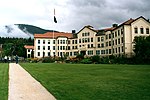Cable House and Station
Alaska Registered Historic Place stubsAlaska building and structure stubsBuildings and structures on the National Register of Historic Places in Sitka, AlaskaCommunications in AlaskaMilitary facilities on the National Register of Historic Places in Alaska ... and 2 more
Sitka, Alaska geography stubsTelecommunications buildings on the National Register of Historic Places

The Cable House and Station, also known as the Communications Center and Quarters, is a historic telecommunications building on Lincoln Street at Harbor Road in Sitka, Alaska. It is a modest two-story building, about 40 feet (12 m) square, with a hip roof. The building housed the telecommunications hub of the Washington-Alaska Military Cable and Telegraph System (WAMCATS), a military communications network established in the first decade of the 20th century, during the period of the Alaska boundary dispute with neighboring Canada.The building was listed on the National Register of Historic Places in 1979.
Excerpt from the Wikipedia article Cable House and Station (License: CC BY-SA 3.0, Authors, Images).Cable House and Station
Harbor Way, Sitka
Geographical coordinates (GPS) Address Nearby Places Show on map
Geographical coordinates (GPS)
| Latitude | Longitude |
|---|---|
| N 57.04866 ° | E -135.33911 ° |
Address
Harbor Way
Harbor Way
99835 Sitka
Alaska, United States
Open on Google Maps








